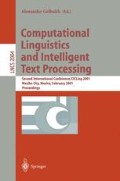Abstract
In this paper we present a whole Natural Language Process- ing (NLP) system for Spanish. The core of this system is the parser, which uses the grammatical formalism Lexical-Functional Grammars (LFG). The system uses the Specification Marks Method in order to resolve the lexical ambiguity. Another important component of this system is the anaphora resolution module. To solve the anaphora, this module con- tains a method based on linguistic information (lexical, morphological, syntactic and semantic), structural information (anaphoric accessibility space in which the anaphor obtains the antecedent) and statistical infor- mation. This method is based on constraints and preferences and solves pronouns and definite descriptions. Moreover, this system fits dialogue and non-dialogue discourse features. The anaphora resolution module uses several resources, such as a lexical database (Spanish WordNet) to provide semantic information and a POS tagger providing the part of speech for each word and its root to make this resolution process easier.
Access this chapter
Tax calculation will be finalised at checkout
Purchases are for personal use only
Preview
Unable to display preview. Download preview PDF.
References
S. Azzam, K. Humphrey, and R. Gaizauskas. Evaluating a Focus-Based Approach to Anaphora Resolution. In Proceedings of the 36th Annual Meeting of the Association for Computational Linguistics and 17th International Conference on Computational Linguistics (COLING-ACL’98), pages 74–78, Montreal (Canada), August 1998.
Dimitris N. Christodoulakis, editor. Second International Conference on Natural Language Processing, NLP’2000, volume 1835 of Lectures Notes in Artificial Intelligence, Patras, Greece, June 2000. Springer-Verlag.
P. Christopherson. The Articles: A study of their theory and use in English. E. Munksgaard, Copenhagen, 1939.
H. H. Clark. Bridging. In P. Johnson-Laird and P Wason, editors, Thinking: readings in cognitive science, pages 411–420. Cambridge University Press, London New York, 1977.
M. Dalrymple, J. Lamping, F. Pereira, and V. Saraswat. Quantifiers, Anaphora, and Intensionality. Journal of Logic, Language, and Information, (6):219–273, 1997.
M. Eckert and M. Strube. Resolving Discourse Deitic Anaphora in Dialogues. In Proceedings of 9th Conference of the European Chapter of the Association for Computational Linguistics (EACL’99), pages 37–44, Bergen, Norway, 1999.
B. Fox. Discourse Structure and Anaphora. Written and conversational English. Cambridge Studies in Linguistics. Cambridge University Press, Cambridge, 1987.
J. A. Hawkins. Definiteness and indefiniteness. Humanities Press, Atlantic Highlands, New Jersey, 1978.
S. Lappin and H. Leass. An algorithm for pronominal anaphora resolution. Computational Linguistics, 20(4):535–561, 1994.
P. Martínez-Barco and M. Palomar. Empirical study of the anaphoric accessibility space in Spanish dialogues. In Proceedings of the Fourth workshop on the Semantics and Pragmatics of Dialogue (GOTALOG’), Göteborg, Sweden June 2000.
P. Martínez-Barco and M. Palomar. Structure-based Anaphoric Accesibility Space. Computational Linguistics, 2000. Submitted.
G. Miller, R. Beckwith, C. Fellbaum, D. Gross, and K. Miller. WordNet: An online lexical database. International journal of lexicography, 3(4):235–244, 1990.
G. Miller, R. Beckwith, C. Fellbaum, D. Gross, and K. Miller. Five Papers on WordNet. International journal of lexicography, Special Issue(3), 1993.
A. Montoyo and M. Palomar. Word Sense Disambiguation with Specification Marks in Unrestricted Texts. In Proc. 11th International Workshop on Database and Expert Systems Applications (DEXA 2000), pages 103–107, Greenwich, London, UK, September 2000. IEEE Computer Society.
R. Muñoz and A. Ferrández. Definite Descriptions Resolution in Spanish. In Proceeding of ACIDCA’2000: Corpora and Natural Language Processing, pages 140–145, Monastir, Túnez, Marzo 2000.
R. Muñoz and M. Palomar. Processing of Spanish Definite Descriptions with the Same Head. In Christodoulakis [2], pages 212–220.
R. Muñoz, M. Palomar, and A. Ferrández. Processing of Spanish Definite Descriptions. In O. Cairo and E. L. Sucar and F. J. Cantu, editor, Proceeding of Mexican International Conference on Artificial Intelligence, volume 1793 of Lectures Notes in Artificial Intelligence, pages 526–537, Acapulco, Mexico, April 2000. Springer-Verlag.
M. Palomar, A. Ferrández, L. Moreno, P. Martínez-Barco, J. Peral, M. Saiz-Noeda, and R. Muñoz. An algorithm for Anaphora Resolution in Spanish Texts. Computational Linguistics (submitted), 2000.
B. Russell. Descripciones. In Luis Ml. Valdés Villanueva, editor, La búsqueda del significado: Lecturas de filosofía del lenguaje, pages 46–56. Tecnos, 1919.
M. Saiz-Noeda and M. Palomar. Semantic Knowledge-driven Method to Solve Pronominal Anaphora in Spanish. In Christodoulakis [2], pages 204–211.
M. Saiz-Noeda, J. Peral, and A. Suárez. Semantic Compatibility Techniques for Anaphora Resolution. In Proceeding of ACIDCA’2000: Corpora and Natural Language Processing, pages 43–48, Monastir, Túnez, Marzo 2000.
M. Saiz-Noeda, A. Suárez, and J. Peral. Propuesta de incorporación de información semántica desde WordNet al análisis sintáctico parcial orientado a la resolución de la anáfora. Procesamiento del Lenguaje Natural, 25:167–173, 1999.
P. Vossen. EuroWordNet: Building a Multilingual Database with WordNets for European Languages. The ELRA Newwsletter. K.Choukri, D.Fry, M. Nilsson (des). ISSN:1026-8200, 3(1), 1998.
Author information
Authors and Affiliations
Editor information
Editors and Affiliations
Rights and permissions
Copyright information
© 2001 Springer-Verlag Berlin Heidelberg
About this paper
Cite this paper
Palomar, M., Saiz-Noeda, M., Muñoz, R., Suárez, A., Martínez-Barco, P., Montoyo, A. (2001). PHORA: A NLP System for Spanish. In: Gelbukh, A. (eds) Computational Linguistics and Intelligent Text Processing. CICLing 2001. Lecture Notes in Computer Science, vol 2004. Springer, Berlin, Heidelberg. https://doi.org/10.1007/3-540-44686-9_12
Download citation
DOI: https://doi.org/10.1007/3-540-44686-9_12
Published:
Publisher Name: Springer, Berlin, Heidelberg
Print ISBN: 978-3-540-41687-6
Online ISBN: 978-3-540-44686-6
eBook Packages: Springer Book Archive

